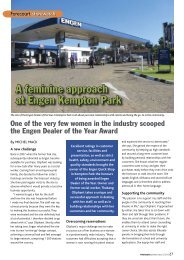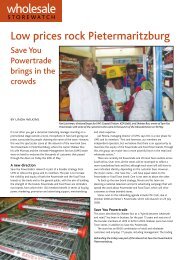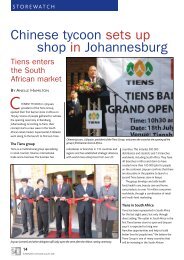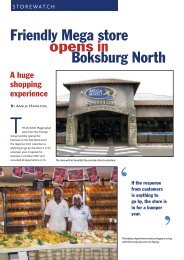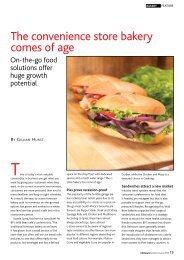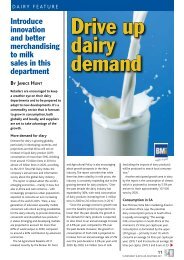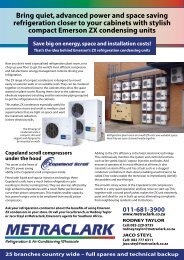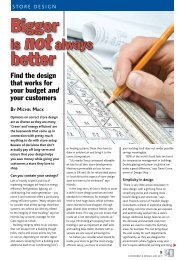Store design When shopping becomes a journey - Supermarket.co.za
Store design When shopping becomes a journey - Supermarket.co.za
Store design When shopping becomes a journey - Supermarket.co.za
You also want an ePaper? Increase the reach of your titles
YUMPU automatically turns print PDFs into web optimized ePapers that Google loves.
STORE DESIGN FEATURE<br />
<strong>Store</strong> <strong>design</strong><br />
Creating<br />
a customer<br />
experience<br />
has be<strong>co</strong>me<br />
the heart<br />
of new store<br />
<strong>design</strong>s<br />
By Mi c h e l Ma c k<br />
<strong>When</strong><br />
<strong>shopping</strong><br />
<strong>be<strong>co</strong>mes</strong><br />
a <strong>journey</strong><br />
The <strong>design</strong>, layout, lighting<br />
and equipment selection of<br />
a store form a major part of<br />
its identity. These influence<br />
the way customers perceive<br />
the store, as well as how<br />
and how much they shop.<br />
“The perfect <strong>design</strong> for one<br />
store usually doesn’t work<br />
for another. Every store<br />
needs to be looked at in its<br />
own right,” says Brendan<br />
Davidson, member of Design<br />
Shop. Individuality is key<br />
and retailers should <strong>co</strong>nsider<br />
a number of factors before<br />
finalising a new <strong>design</strong>.<br />
The new shop(per)s<br />
Customers obviously <strong>co</strong>me to a<br />
supermarket for a purpose. Be it a quick<br />
shop for a few items or the monthly stockup<br />
– customers want a <strong>co</strong>nvenient and<br />
inviting store that is easy to oversee, quick<br />
to use and easy to familiarise themselves<br />
with. “The trends are leaning towards<br />
creating a <strong>co</strong>mfortable environment in<br />
which the shopper feels they would like<br />
to return frequently. The ‘psychology’ of<br />
what keeps customers in the store for<br />
longer is be<strong>co</strong>ming an important aspect of<br />
its <strong>design</strong>,” says Taryn Constable, owner of<br />
Design Vision.<br />
Retailers have put a large focus on<br />
creating this <strong>co</strong>mfortable environment.<br />
<strong>Store</strong>s are no longer clinically <strong>co</strong>ld<br />
and simply functional environments.<br />
Instead, <strong>co</strong>lours, <strong>design</strong> and signage<br />
enable interaction with customers. Many<br />
supermarkets have in<strong>co</strong>rporated large<br />
lifestyle graphics on the walls with enticing<br />
messages and quotes to inspire customers.<br />
Pictures of fresh products are used to<br />
arouse the customer’s appetite and initiate<br />
impulse sales.<br />
“Our society has be<strong>co</strong>me more aware<br />
of the environment and this resonates in<br />
store <strong>design</strong>. Natural stone cladding and<br />
reclaimed timber finishes give the store<br />
a more natural and earthy feel,” says<br />
Constable. Technical innovations enable<br />
large electricity savings, and therefore cut<br />
down on running <strong>co</strong>sts and raise the store’s<br />
green reputation.<br />
“Trends in store <strong>design</strong>, especially in<br />
terms of <strong>co</strong>lour and materials, are everchanging.<br />
The FMCG market, in particular,<br />
puts major emphasis on functionality and<br />
<strong>co</strong>st effectiveness. Every aspect of <strong>design</strong><br />
nowadays is focused on delivering a return<br />
on investment,” says Danie Grove, member<br />
of Design Shop. “Contrary to international<br />
trends, hypermarkets are experiencing<br />
11<br />
SUPERMARKET & RETAILER, JUNE 2012<br />
▲
The psychology of making customers feel <strong>co</strong>mfortable and at home has be<strong>co</strong>me a major aspect of store <strong>design</strong>. Creating warmth and excitement are<br />
key elements in ensuring that a customer returns to the store frequently. Many retailers have introduced innovative departments or organised events<br />
to keep the excitement going. Woolworths Ni<strong>co</strong>lway in<strong>co</strong>rporated a show kitchen and uses its ties to MasterChef SA for added excitement.<br />
STORE DESIGN<br />
a decline in South Africa. Trends are going<br />
towards hybrid stores, in<strong>co</strong>rporating both<br />
wholesale and retail, especially in the low<br />
in<strong>co</strong>me segment,” adds Davidson.<br />
Create flow<br />
▲<br />
Creating a nicely flowing store with<br />
strategic layout of the departments,<br />
which leads customers past the featured<br />
departments, is a key aspect in modern<br />
store <strong>design</strong>. “In terms of flow, it is<br />
important for all shelves to face the same<br />
direction as this enables customers to<br />
have an easy overview of the store. It<br />
is also beneficial for security purposes,”<br />
says Constable. Most stores are organised<br />
clockwise and retail chain stores must<br />
generally stick to the same layout across<br />
their stores for customers to easily find<br />
products where they would expect them,<br />
as well as to create a <strong>co</strong>mmon look and<br />
feel across the group.<br />
“Shops are also starting to adopt the<br />
overseas trend of having separate entrances<br />
12<br />
SUPERMARKET & RETAILER, JUNE 2012<br />
and exits,” she says. This has been done at<br />
the newly opened Woolworths Ni<strong>co</strong>lway<br />
and causes less <strong>co</strong>nfusion from a security<br />
point of view, eases the traffic through the<br />
store and avoids <strong>co</strong>ngestion.<br />
“<strong>Store</strong> layout is always a matter of<br />
preference and practicality,” she <strong>co</strong>ntinues.<br />
However, heavy items like bulk <strong>co</strong>ld drinks<br />
should always be placed at the end of the<br />
<strong>shopping</strong> trip, so that shoppers don’t have<br />
to carry them through the entire store. The<br />
same applies for frozen products to make it<br />
easier for customers to maintain the <strong>co</strong>ld<br />
chain beyond the shop doors – which is<br />
why island freezers are usually placed at<br />
the end of the store. It is advisable to place<br />
dairy products close to the tills, as a leaking<br />
sachet of milk, for example, might leave<br />
a trail through the entire store. Products<br />
that are easily broken, such as eggs, are<br />
also best placed at the end of the <strong>shopping</strong><br />
trip to avoid customers placing them at<br />
the bottom of their baskets. “Retailers<br />
understand that the more <strong>co</strong>nvenient<br />
you make it for the customer, the more<br />
purchases they will make,” adds Constable.<br />
Green, greener, greenest<br />
“One of the major trends that has<br />
emerged, and is <strong>co</strong>ntinuously growing, is<br />
in<strong>co</strong>rporating sustainable elements into<br />
the <strong>design</strong>,” says Design Shop’s Brendan<br />
Davidson. Next to building a positive<br />
image in an increasingly environmentally<br />
aware society, it has also simply be<strong>co</strong>me<br />
a necessity to preserve energy to keep the<br />
shop’s operating <strong>co</strong>sts in check.<br />
“Going green has affected every aspect<br />
of retailing – from product and material<br />
procurement to lighting. It has also<br />
influenced the way electrical appliances are<br />
handled. Power <strong>co</strong>nsumption needs to be<br />
light and retailers are rethinking how they<br />
specify their store’s requirements,” adds<br />
Design Shop’s Danie Grove.<br />
Previously, refrigeration cabinets had<br />
between 15 and 18 doors and retailers<br />
have now started to reduce the amount<br />
of cabinets by differentiating between<br />
products usually purchased for immediate<br />
<strong>co</strong>nsumption, and products that are usually<br />
taken home. A 330ml can of Coke, for<br />
▲
LIGHTING<br />
Your Commercial Lighting Specialists<br />
48 Marine Drive, Paarden Eiland, Cape Town, South Africa<br />
Telephone 021 511 6116 Facsimile 021 511 7662<br />
email: info@lightsbylinea.<strong>co</strong>m<br />
www.lightsbylinea.<strong>co</strong>.<strong>za</strong><br />
Follow us<br />
on Facebook
STORE DESIGN<br />
▲<br />
example, is generally bought for immediate<br />
<strong>co</strong>nsumption and kept refrigerated in-store,<br />
whilst the 2l bottles of <strong>co</strong>ke are usually<br />
taken home – therefore retailers have<br />
started moving them out of the fridges,<br />
reducing the amount of cabinets required<br />
and electricity <strong>co</strong>nsumed.<br />
“Home meal replacements (HMR) should<br />
also be <strong>co</strong>nsidered. Most of it is taken<br />
home and reheated for supper, therefore<br />
there is rarely a need to <strong>co</strong>ntinuously keep<br />
food hot and have equipment <strong>co</strong>nsume<br />
electricity,” adds Davidson.<br />
Something else to investigate would<br />
be opportunities to recycle energy and<br />
in<strong>co</strong>rporate provisions for the use of<br />
alternative energy sources. “A growing<br />
trend overseas is to generate electricity via<br />
solar panels on the store’s roof. It is not<br />
too viable yet in South Africa, but will be<br />
once provisions are made to sell unused<br />
electricity back into the grid to balance out<br />
the demand. Architects should therefore<br />
<strong>design</strong> the roofs in a way that they can<br />
ac<strong>co</strong>mmodate such a system,” he says.<br />
▲<br />
<strong>When</strong> looking at reducing energy <strong>co</strong>nsumption, HMR should be examined a bit closer. Most meals<br />
are taken home and reheated, eliminating the need to <strong>co</strong>nstantly be kept hot in-store. Key here is<br />
to find the balance to cater for both people buying for quick lunches and people buying to take<br />
home to their family.<br />
<strong>Store</strong>quip Group<br />
WORLD LEADER<br />
IN ELECTRONIC<br />
SHELF LABELING*<br />
Reliable radio system<br />
Therefore no need for Bi-directional ESLs<br />
The data is guaranteed to reach the ESL as<br />
the transmission is not effected by obstacles<br />
A modern system, <strong>co</strong>mpletely automated<br />
which allows you to forget the difficulty of changing prices<br />
How does it work?<br />
For each price change, the information <strong>co</strong>mes automatically from<br />
your back office and transmits directly through radio frequency to the ESL.<br />
Thanks to the<br />
That’s not all...!<br />
14<br />
SUPERMARKET & RETAILER, JUNE 2012<br />
STOREQUIP<br />
Marketing (Pty) Ltd<br />
Reg. No. 2002/032169/07<br />
Electronic Shelf Labels<br />
system you can:<br />
Unmatched Legibility<br />
New mounting systems<br />
Innovative <strong>design</strong><br />
1. Reduce your operating <strong>co</strong>sts<br />
2. Be sure of having the same price at your shelves and your POS<br />
3. Be sure of having a price in front of each product ( fixing patent)<br />
4. Reduce the loss of margin due to price mistakes<br />
Automate price changes<br />
The most advanced label on the market:<br />
The only label capable of performing internal calculations, which has<br />
13 memories allowing “happy hour” pricing in your store without any <strong>co</strong>sts<br />
For more information,<br />
please <strong>co</strong>ntact Graham:<br />
TEL: +2711 724 1500<br />
WEBSITE: www.ses-esl.<strong>co</strong>m<br />
E-mail: esl@storequip.<strong>co</strong>.<strong>za</strong><br />
414 Heidelberg Road, Tulisa Park<br />
Private Bag X036, Alberton, 1450<br />
Johannesburg
Mother Nature is our biggest fan . . .<br />
We can boast about our patented energy saving, <strong>co</strong>st cutting,<br />
e<strong>co</strong>-efficient, Ozone friendly, world class refrigeration cabinets.<br />
We can brag about our unique fluid <strong>co</strong>oled, self-<strong>co</strong>ntained<br />
refrigeration cabinets offering up to 50% savings in energy <strong>co</strong>nsumption.<br />
We can tout about the fact that our standard self <strong>co</strong>ntained units<br />
(12ft upright and 12ft Jumbo island) use as little as 2.8 Amps<br />
and a maximum of 3.8 Amps.<br />
We can gloat about how our installation time is reduced to 2 - 3<br />
weeks <strong>co</strong>mpared to the typical turn around time of 2 - 4 months,<br />
saving you up to 15%.<br />
We can wax lyrical about our unique monitoring and reporting<br />
mechanism that tracks, amongst other things, every temperature<br />
spike or power failure.<br />
We can tell you all about the endless unique product features but,<br />
weʼd much rather show you. After all, seeing is believing.<br />
Call us now to make an appointment to visit our fully functioning test room at our ISO rated factory,<br />
or weʼll send one of our Omega reps to visit you.<br />
Call 08600 OMEGA or email us at sales@omegaref.<strong>co</strong>m
STORE DESIGN<br />
▲<br />
Electricity can also be saved by the use<br />
of heat pumps for hot water instead of<br />
<strong>co</strong>nventional geysers, as well as re-using<br />
heat generated by other appliances in the<br />
store.<br />
“Both heating and <strong>co</strong>oling are<br />
responsible for the majority of a store’s<br />
power <strong>co</strong>nsumption. There are many new<br />
advances in the use of heat re<strong>co</strong>very<br />
techniques that are able to harness the<br />
heat given off from existing equipment for<br />
the use in heating of the water supply used<br />
in kitchen, change rooms etc.,” adds Design<br />
Vision’s Taryn Constable.<br />
Air curtains should be used at the store<br />
entrance to keep <strong>co</strong>ld air inside and reduce<br />
the requirements on the air <strong>co</strong>nditioning<br />
systems. Likewise, delivery entrances<br />
should be fitted with PVC strip curtains.<br />
Refrigerated units should be placed as far<br />
from the entrances as possible to prevent<br />
hot air drawing in from the doors, putting<br />
an additional strain on the systems.<br />
“An additional aspect that is often<br />
underestimated is having proper waste<br />
management procedures in place to ensure<br />
sustainability,” adds Davidson.<br />
Light up<br />
Upgrading store lighting can increase<br />
energy efficency, as well as create a<br />
wel<strong>co</strong>ming and <strong>co</strong>mfortable <strong>shopping</strong><br />
experience for customers. Upgrading<br />
lighting systems with newer technologies<br />
can reduce maintenance <strong>co</strong>sts as well.<br />
▲<br />
Tile details can be in<strong>co</strong>rporated to help with flow and lead customers through the store.<br />
Give your store a face lift<br />
without a revamp<br />
Innovative bespoke <strong>design</strong>s<br />
Great for focal points and promotional areas<br />
Strong, adjustable and very durable<br />
Solutions for all categories of merchandise available<br />
For more information on how we can solve your merchandising needs call us at 0861-11-3680 or visit www.euroshelf.<strong>co</strong>m<br />
16<br />
SUPERMARKET & RETAILER, JUNE 2012
STORE DESIGN<br />
▲<br />
LEDs are be<strong>co</strong>ming<br />
more popular as they offer<br />
many advantages over<br />
older technologies<br />
“Using fluorescant lighting and halogen<br />
for general lighting in store is still <strong>co</strong>mmon<br />
practice. Flourescent lighting is still an<br />
efficient technology, but if halogen lighting<br />
has been used for accent purposes, then<br />
light-emitting diodes (LEDs) are a suitable<br />
replacement,” says Grahame Boyle, MD<br />
of Osram South Africa. “However, it is<br />
important to decide on the approprite<br />
technology as LEDs cannot replace all lamp<br />
sources just yet. We are seeing massive<br />
growth and development in the LED sector<br />
and within a short period, we will see it<br />
used increasingly for general lighting too,”<br />
he adds.<br />
The <strong>co</strong>mmon T8 (26mm diameter)<br />
flourescent tube is slowly being superseded<br />
by a more efficent T5 (16mm diameter)<br />
flourescent lamp. The <strong>co</strong>rrect selection of<br />
<strong>co</strong>lour temperature and <strong>co</strong>lour rendering<br />
properties for the application ensures<br />
<strong>co</strong>rrectly illuminated merchandise and<br />
enhances the customer experience.<br />
New store <strong>design</strong>s have started<br />
in<strong>co</strong>rporating skylights, creating the ability<br />
to illuminate a store with natural light,<br />
decreasing the requirements for artificial<br />
lighting. Light management systems<br />
can automatically <strong>co</strong>ntrol the lighting<br />
It is important to choose the right <strong>co</strong>lour lighting to ensure<br />
that produce looks appealing at all times.<br />
18<br />
SUPERMARKET & RETAILER, JUNE 2012
throughout the day, maintain a <strong>co</strong>nstant<br />
light level and significantly reduce energy<br />
<strong>co</strong>nsumption.<br />
LEDs are be<strong>co</strong>ming more popular as<br />
they offer many advantages over older<br />
technologies. Their lifespan exceeds<br />
<strong>co</strong>nventional lights almost tenfold, whilst<br />
boasting low power <strong>co</strong>nsumption and<br />
emitting almost no heat. They are available<br />
in many forms and sizes and can therefore<br />
be used in a wide range of applications,<br />
including illuminating sensitive products.<br />
“<strong>When</strong> developing a <strong>co</strong>ncept with a store<br />
<strong>design</strong>er, all applications depend on what<br />
they want the store to look like. Correct<br />
<strong>co</strong>lour and rendering vitally influence how<br />
the products lit will actually look,” adds<br />
Boyle. The <strong>co</strong>lour of what is perceived<br />
as ‘normal’ light is made up of red, blue<br />
and green elements, mixed at different<br />
intensities to create different <strong>co</strong>lours for<br />
various applications. The wrong <strong>co</strong>lour<br />
lighting fitted to the butchery <strong>co</strong>unters, for<br />
example, can make perfectly fresh meat<br />
look grey and unappealing.<br />
Dynamic lighting is slowly being adapted<br />
into the retail sector and assists in creating<br />
‘mood’. Using movement and <strong>co</strong>lour will<br />
attract customers and add to the message<br />
the store is trying to portray.<br />
“<strong>When</strong> <strong>co</strong>nsidering a lighting <strong>co</strong>ncept<br />
or layout, it is important to <strong>co</strong>nsider the<br />
payback period. New technologies can<br />
be expensive but often enable significant<br />
savings that make a viable difference on<br />
the electricity bill,” adds Mark Greenhill,<br />
technical manager at Osram South Africa.<br />
Lifestyle graphics on the wall inspire customers with inviting messages and quotes.<br />
This helps to give the store a more inviting and less clinical feel.<br />
Floor matters<br />
“Flooring within retail stores has mostly<br />
moved to either epoxy finishes or polished<br />
<strong>co</strong>ncrete flooring, with a strong tendency<br />
towards the epoxy side,” says Rean Fouché,<br />
▲<br />
Innovative Solutions<br />
In Retail Lighting<br />
Corporate lighting strengthens your brand<br />
image, creating individually to stand out from<br />
your <strong>co</strong>mpetitors.<br />
Integration of exceptional product presen -<br />
ta tion with the shop <strong>design</strong> <strong>co</strong>ncept.<br />
Increase sales with effective display lighting.<br />
Careful and thorough planning.<br />
Cape Quarter Spar<br />
Targeted use of the latest lighting<br />
tech nologies.<br />
Optimised product development and <strong>design</strong>.<br />
14 platinum junction, school road, milnerton 7441, cape town<br />
p.o. box 1799, milnerton 7435 · tel +27 21 552 6738<br />
fax +27 86 694 2588 · mobile +27 84 291 3639<br />
email info@euro<strong>co</strong>ncepts.<strong>co</strong>.<strong>za</strong> · www.euro<strong>co</strong>ncepts.<strong>co</strong>.<strong>za</strong>
Retailers<br />
do well to stay away<br />
from floor tiles. They<br />
break easily and are<br />
<strong>co</strong>stly to maintain<br />
and replace<br />
STORE DESIGN<br />
▲<br />
<strong>co</strong>ntract manager of Seal Con Systems.<br />
Within the polished <strong>co</strong>ncrete finish,<br />
<strong>co</strong>ncrete is ground down to expose<br />
arrogates and bring a marble type finish,<br />
which is rather time <strong>co</strong>nsuming and<br />
expensive. Retailers lean towards epoxy<br />
finishes, which <strong>co</strong>me out similar to <strong>co</strong>lour<br />
stone type finishes, as they are long-lasting<br />
and much quicker to install – which is<br />
important as store openings are usually<br />
bound to a tight schedule.<br />
“In terms of main selection criteria,<br />
flooring is no different from any other<br />
aspect of store <strong>design</strong>. Clients want flooring<br />
that lasts the longest and looks the best,”<br />
he says. Retailers usually go for a matte<br />
finish as it is easier to maintain and more<br />
durable in high traffic areas.<br />
Fouché emphasises that retailers should<br />
ensure that the right <strong>co</strong>ncrete is used<br />
during the <strong>co</strong>nstruction process. “It needs<br />
to have a strength of at least 25mpa,<br />
verified by impact test, or else it will be<br />
too soft to work with,” he adds. Finished<br />
flooring elements tend to curl slightly<br />
once fitted and dry – which is generally no<br />
problem and planned for – but can rip the<br />
<strong>co</strong>ncrete apart when too soft. The flooring<br />
itself should be at least 2mm thick and<br />
have high wear resistance.<br />
With proper maintenance, flooring can<br />
then last way beyond 20 years. “It should<br />
be cleaned two to three times a day and<br />
the expansion joints must be maintained<br />
<strong>co</strong>ntinuously,” says Fouché. Expansion<br />
joints absorb the movement of the floor<br />
elements and failure to maintain them<br />
leads to them not sealing properly and<br />
letting water get underneath, lifting the<br />
floor and ultimately, destroying it.<br />
“Every retailer does well to stay away<br />
from tiles. They break easily and are <strong>co</strong>stly<br />
to maintain and replace,” he adds.<br />
Fitting fittings<br />
Once the structure is dealt with, attention<br />
needs to be paid to what goes inside the<br />
Trends in retail fittings have moved to hybrid units, such as those made of wood with aluminium<br />
finishes. Sole aluminium units were the units of choice for a long time, but have lost popularity<br />
due to exorbitant aluminium prices.<br />
20<br />
SUPERMARKET & RETAILER, JUNE 2012
Replacing <strong>co</strong>nventional signs and menu boards with digital signage<br />
helps modernise the store and simplify customer interaction.<br />
new store. “The <strong>co</strong>rrect selection of<br />
fittings is extremely important, as the<br />
wrong selection will not display the<br />
products <strong>co</strong>rrectly and improper display<br />
systems can easily <strong>co</strong>llapse,” says Hylton<br />
Kramer, manager of Display Equipment in<br />
Johannesburg.<br />
During the last 10 years, the industry<br />
has largely moved away from the pegboard<br />
system. The lower end market has adopted<br />
the industrial-look wire mesh system and<br />
upper end retailers have moved to the<br />
slatwall system, enabling custom isation<br />
through a variety of available inserts. Both<br />
systems are modular systems and give<br />
retailers a lot of room to customise it for<br />
their needs. Internationally – and in South<br />
Africa – the Tubal-C system is gaining<br />
momentum as, unlike other systems, it can<br />
be used against dry-walling because its<br />
weight is held by gravity and not against<br />
the wall. Some retail customers also opt for<br />
free-standing units as they give maximum<br />
flexibility in different setups.<br />
In terms of materials, wood, metal,<br />
aluminium and glass are most <strong>co</strong>mmonly<br />
selected by the <strong>design</strong>ers, as well as<br />
Perspex. “The choice of materials is<br />
obviously dependant on application and<br />
desired look. Generally, retailers rather<br />
differentiate themselves through <strong>co</strong>lour<br />
as opposed to the type of fittings. For<br />
a long time there was a great demand<br />
for aluminium fittings, but due to its<br />
exorbitant prices, trends have moved<br />
towards hybrid units,” he says. Hybrid units<br />
<strong>co</strong>nsist of a <strong>co</strong>mbination of materials, such<br />
as a wooden shelf with aluminium dé<strong>co</strong>r to<br />
achieve a specific look.<br />
“Retailers need to be aware that the<br />
market has been flooded with a vast<br />
number of Chinese knock-off products.<br />
Those products might look the same,<br />
▲<br />
21<br />
SUPERMARKET & RETAILER, JUNE 2012
TheWorldinMotion.<br />
TENTE istheleading<br />
South African<br />
manufacturer<br />
andsupplierof<strong>co</strong>st<br />
effectivecastor<br />
solutionsforRetail,<br />
Distribution,Wholesale<br />
andMaterialsHandling<br />
operations.<br />
STORE DESIGN<br />
▲<br />
but do not offer the required strength and<br />
easily <strong>co</strong>llapse, creating a serious danger<br />
within a store environment,” adds Kramer.<br />
Take your store into<br />
the 21st century<br />
Technology has a growing impact on how<br />
stores are <strong>design</strong>ed and utlised by shoppers.<br />
“Interestingly enough, those changes are<br />
mostly driven by the shoppers themselves<br />
who are be<strong>co</strong>ming more knowledgable<br />
and technologically sophisiticated,” says<br />
Andrew Ridl, MD of One Digital Media.<br />
<strong>Store</strong>s are increasingly fitted with digital<br />
signage, which <strong>co</strong>mes in the shape of<br />
on-shelf screens, ad screens around the<br />
store, as well as interactive desks for<br />
customers. Changing screens attract<br />
more attention from customers than<br />
<strong>co</strong>nventional posters, and <strong>co</strong>ntent is<br />
changed at the push of a button. This can<br />
be used to promote current specials, push<br />
products that are close to their sell-by<br />
date, or simply wish customers a good day.<br />
It is often used for HMR departments to<br />
display the menu, as items and prices can<br />
easily be changed without incurring added<br />
printing <strong>co</strong>sts. “An ever increasing amount<br />
of digital media networks are being<br />
deployed in-store. Retailers realise the<br />
value this dynamic medium offers in terms<br />
of improving the <strong>shopping</strong> experience,<br />
UFSERIES<br />
HUSERIES<br />
New store developers started in<strong>co</strong>rporating skylights into their <strong>design</strong>. These illuminate the store<br />
with natural light during the day. This way, electricity is saved by reduced lighting requirements.<br />
UA SERIES<br />
Natural stone cladding is used to give a store a more natural and earthy feel.<br />
22<br />
SUPERMARKET & RETAILER, JUNE 2012
Design Vision’s Taryn Constable<br />
emphasises that the outside of a store is<br />
often not <strong>co</strong>nsidered sufficiently in relation<br />
to the inside <strong>design</strong>. “Shopfront <strong>design</strong> and<br />
external façade <strong>design</strong> should all tie in with<br />
the interior <strong>co</strong>ncept to create a whole,” she<br />
says.<br />
Customers must be able to move<br />
through the store easily and get an idea<br />
of where to find their desired items<br />
the moment they walk into the store.<br />
Confusing layouts and cluttered setups<br />
frustrate customers and make their<br />
<strong>shopping</strong> experience unpleasant.<br />
<strong>Store</strong> <strong>design</strong> must always be chosen in<br />
<strong>co</strong>njunction with the store’s target market.<br />
“One cannot give a client an expensive<br />
fancy store when its patrons are on a<br />
lower in<strong>co</strong>me level – the store will be<br />
intimidating and uninviting to people as it<br />
gives them the feel of being too expensive<br />
for them,” she says.<br />
“Clients pay for every square metre of<br />
space used and therefore every square<br />
metre within the store must be <strong>design</strong>ed to<br />
be as efficient as possible, aligned with the<br />
target market and delivering a good return<br />
on investment,” <strong>co</strong>ncludes Constable.<br />
▲<br />
Arousing the customer’s appetite via relevant<br />
signs is an effective way of pushing meat and<br />
fresh produce sales.<br />
marketing agility and ultimately increasing<br />
the store’s revenue. Solutions are now<br />
being integrated into store <strong>design</strong>s at the<br />
outset,” he <strong>co</strong>ntinues.<br />
Confusing layouts and<br />
cluttered setups frustrate<br />
customers and make<br />
their <strong>shopping</strong> experience<br />
unpleasant<br />
Common mistakes<br />
“About 95% of supermarkets fail to<br />
implement facilities for product-related<br />
information,” adds Design Shop’s Danie<br />
Grove. Shelf talkers are an easy way to<br />
educate customers and suggest uses for<br />
new and unusual products on the shelves.<br />
This serves as a great way of pushing<br />
sales. “Retailers also need to create more<br />
excitement within their stores,” adds<br />
Davidson.<br />
Within shops catering for lower LSM<br />
customers, PA systems are often installed<br />
to play music and get customers in a<br />
good mood. Similar elements <strong>co</strong>uld add a<br />
great deal to the higher end supermarkets<br />
as well. The right ad agency needs to be<br />
chosen to use the facilities effectively and<br />
create exciting promotions that keep the<br />
shopper’s lives interesting.<br />
Parking is also an aspect that is<br />
often forgotten about. “No matter how<br />
innovative a new store is, if customers<br />
are not provided with sufficient parking<br />
and easy access, the store will always stay<br />
below its potential,” <strong>co</strong>ncludes Davidson.<br />
Pallet Racking<br />
Industrial Shelving<br />
Hardware Gondola<br />
<strong>Supermarket</strong> Gondola<br />
Wholesale Gondola<br />
23<br />
SUPERMARKET & RETAILER, JUNE 2012
<strong>Store</strong><br />
<strong>design</strong><br />
checklist<br />
Co m p i l e d<br />
by La u r a Du r h a m<br />
<strong>When</strong> <strong>co</strong>nsidering a revamp or<br />
whether to build a store from<br />
scratch, you need to <strong>co</strong>nsider a<br />
number of factors. The list might<br />
seem exhaustive but with proper<br />
expert <strong>co</strong>nsultation, you should be<br />
able to find the balance between<br />
functionality, <strong>co</strong>st effectiveness<br />
and shopper experience. After all,<br />
the more <strong>co</strong>nvenient you make the<br />
<strong>shopping</strong> <strong>journey</strong> for the customer,<br />
the more purchases they will make<br />
in your store.<br />
Focus on the customer:<br />
■ Create a <strong>co</strong>mfortable environment,<br />
rather than a clinically <strong>co</strong>ld and simply<br />
functional one.<br />
■ Use <strong>co</strong>lours, <strong>design</strong> and signage to<br />
interact with customers throughout<br />
your store.<br />
■ Use appealing product pictures to<br />
arouse customers’ appetites and<br />
in<strong>co</strong>rporate lifestyle messages to inspire<br />
them.<br />
■ Digital signage allows for more<br />
interaction with customers. For example,<br />
on-shelf screens, ad screens around the<br />
store and interactive customer kiosks.<br />
■ Create excitement in your store through<br />
wet demos, easy-listening music and<br />
promotional activities set up all along<br />
their <strong>journey</strong>.<br />
Create a <strong>shopping</strong> <strong>journey</strong>:<br />
■ Create an easy flowing store by<br />
strategically laying out departments to<br />
naturally lead customers through the<br />
store.<br />
■ All shelves should face the same<br />
direction to give customers an easy<br />
overview of the store.<br />
■ Some stores are starting to have<br />
separate entrances and exits – this eases<br />
traffic through the store and avoids<br />
shopper <strong>co</strong>ngestion<br />
Energy efficiency:<br />
■ Place refrigerated units as far from<br />
the entrances as possible to prevent<br />
hot air drawing in from the doors,<br />
putting an additional strain on the<br />
systems.<br />
■ Consider opportunities to recycle<br />
energy. For example, using heat<br />
pumps for hot water in-store and heat<br />
reclamation.<br />
■ Look at alternative energy sources, such<br />
as solar panels on the roof to power<br />
some aspects of your store.<br />
Lighting:<br />
■ Consider light-emitting diodes (LEDs),<br />
which have a lifespan that exceeds<br />
<strong>co</strong>nventional lights almost tenfold,<br />
whilst boasting low power <strong>co</strong>nsumption<br />
and emitting almost no heat.<br />
■ In<strong>co</strong>rporate light management systems,<br />
which automatically <strong>co</strong>ntrol the lighting<br />
throughout the day, maintain a <strong>co</strong>nstant<br />
light level and significantly reduce<br />
energy <strong>co</strong>nsumption.<br />
■ In<strong>co</strong>rporate skylights so the store can be<br />
illuminated by natural light, decreasing<br />
the need for artificial lighting.<br />
■ Adopt dynamic lighting to assist with<br />
creating mood by using <strong>co</strong>lour and<br />
movement.<br />
Flooring:<br />
■ Stay away from tiles – they break<br />
easily and are <strong>co</strong>stly to maintain and<br />
replace.<br />
■ Consider epoxy finishes for flooring as<br />
they are long-lasting and much quicker<br />
to install.<br />
■ A matte finish is easier to maintain and<br />
more durable in high traffic areas.<br />
■ Maintain your flooring. Expansion joints<br />
absorb the movement of the floor<br />
24<br />
SUPERMARKET & RETAILER, JUNE 2012
elements and failure to maintain them<br />
leads to them not sealing properly and<br />
letting water get underneath, lifting the<br />
floor and ultimately, destroying it.<br />
Fittings:<br />
■ In<strong>co</strong>rporate green elements such as<br />
natural stone cladding and reclaimed<br />
timber finishes.<br />
■ Select the <strong>co</strong>rrect fittings. The wrong<br />
selection will not display the products<br />
<strong>co</strong>rrectly and improper display systems<br />
can easily <strong>co</strong>llapse.<br />
■ Follow the industry trend of moving<br />
away from the pegboard system.<br />
The lower end market seems to have<br />
adopted the industrial-look wire mesh<br />
system and the upper end of the<br />
spectrum is choosing a slatwall system.<br />
■ Take note that the Tubal-C system is<br />
gaining momentum as, unlike other<br />
systems, it can be used against drywalling<br />
because its weight is held by<br />
gravity and not against the wall.<br />
■ Be aware that the market has been<br />
flooded with a vast number of poor<br />
quality Chinese knock-off products.<br />
Heating, air-<strong>co</strong>n and refrigeration are responsible for the majority of a store’s electricity<br />
<strong>co</strong>nsumption. Hot water return systems are able to ‘recycle’ reclaimed heat from the refrigeration<br />
units and help reduce electricity <strong>co</strong>nsumption. Reclaimed heat can also be used to heat the store.<br />
25<br />
SUPERMARKET & RETAILER, JUNE 2012



